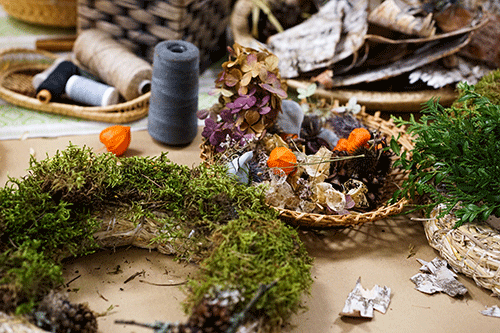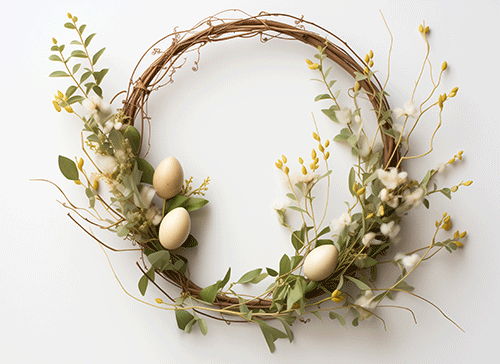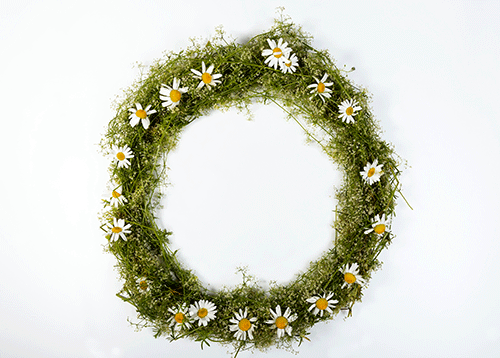Over the past few years, there has been an increasing trend in people decorating their homes to suit all seasons. Of course, Christmas and Halloween have always been popular events for dressing up the home, but recent years have seen an increase in autumnal and spring home decor too.
With the prospect of lighter evenings and milder days on the way, we wanted to share some inspiration and embrace the new season by sharing ideas on how to add a bit of spring to your home - without hurting the planet.
We all know that seasonal decor can be wasteful, many of us not re-using the same accessories the following year. Did you know that 66.9 million homeware items are thrown away each year!
Below, we show how easy it is to create a spring wreath that will naturally compost back into the ground at the end of the season, leaving virtually no footprint behind.
What you’ll need:
- A base for your wreath
- Moss
- Foliage, branches and twigs
- Flowers (and water spritzer if you want to keep them fresh)
- Garden wire, twine or string (the more natural, the better)
- Optional: egg shells
Step 1: Find a base for your wreath
If you’ve had a wreath professionally made before, then you could re-use the base ring. Or, if you’ve got a wreath still stuck in the cupboard from Christmas you could repurpose that.
You could also buy one from a shop made from willow - which you can re-use and re-decorate over and over.
However, the most sustainable thing to do is to make your own by snipping off a few flexible branches from a Hazel tree or a Willow tree.
Step 2: Find things to forage for

Moss makes a fantatic base for your wreath. You can often find moss in shady, moist areas of your back garden, or living in places where water flows.
Moss is bright green when it’s been raining but when the weathers been a bit drier, it will turn a little more yellow.
Once you have your moss for your base, you’ll want to begin foraging for decorations like twigs and flowers. Before you begin foraging, ensure to wear a nice thick pair of gloves to protect your hands from thorns. Also, make sure to be wary of any dog or other animal waste when you're foraging outside your own garden!
Most things can be found along hedgerows and even in your own garden, including Laurel (a common leaf found in many gardens and that will add a real lush thickness to your design).
While daffodils might be the flower of the season here in the UK - you shouldn’t pick these unless they’re from your own garden.
Under the 1981 Wildlife & Countryside Act, it’s illegal in the UK to “pick, uproot or destroy any wild plant without permission from the landowner or occupier”. This means it’s illegal for you to pick daffodils from any park, roundabout or verge that the council maintains.
However, it’s normally not an offence to pick fruit, foliage and flowers that are growing wild, so just make sure you’re not taking from private land before taking your forages home.
If you can’t find exactly what you are looking for, don’t go and buy it… think creatively. Why not have a rummage through old decorations to see what you can re-use rather than throwing them away? Perhaps from an Easter bonnet that’s seen better days?
Step 3: Use your moss to fill out the base of your wreath
Once you have your wreath ring, take handfuls of your moss and separate them into piles.
The size of your wreath ring will help determine how many layers of moss you need. Then, working round your ring, attach each moss-bundle using wire or string.
If you’ve collected leaves, you can separate them into piles depending on their size. Then layer them up starting with one larger one at the bottom and ending up with a small one on top. You can then tie these little bundles together.
Step 4: Attach your natural decorations
It’s up to you how you decorate your wreath, but there is so much inspiration online if you get a bit stuck. We’ve included a few of our favourite designs below.
Working symmetrically will ensure your wreath looks considered and professional.
It can be helpful to add little bits of garden wire to your flower stems, allowing you to poke them securely into your wreath.
If you are feeling particularly adventurous, and want to add an Easter theme to your wreath, you could look at blowing eggs (removing the egg content whilst keeping the shell intact) and decorating them with sustainable twine and paint. Or if you want to keep it simple yet effective, broken half-egg shells can add a delicate and pretty feel to your wreath.>/p>
In both instances a little needle and thread can be used to piecer the shell and attach to your wreath. Alternatively you could use a glue gun.

But sometimes the simplest designs can be the prettiest. Take for example this moss and daisy wreath which we just love.

Keeping your wreath fresh
Remember that hard berries, twigs, fir and evergreen leaves will last the longest. If you have flowers then you can either replace them with fresh ones every few days – or, if you want your wreath to last longer, you will need to keep them moist.
Spraying your wreath with water each day is the easiest method. If you have packed your moss tightly enough then it will act as a natural absorbent, keeping your flower stems moist.
By hanging your wreath outside, you will help to keep it fresh… but remember frosts are still possible in early spring so do make sure it is covered if the forecast predicts a chilly spell.
More inspritation
With more people than ever before keen to make sustainable changes in their lives, we're keen to help you keep up with the trends - without hurting the planet. Check out a few more of our blogs here:
Sustainable tips on planting your own veg
Have you tried a re-fill shop?
How to create a outdoor eco-space